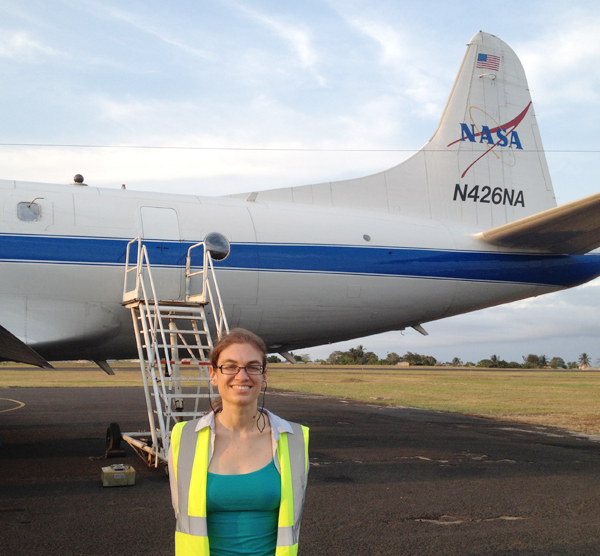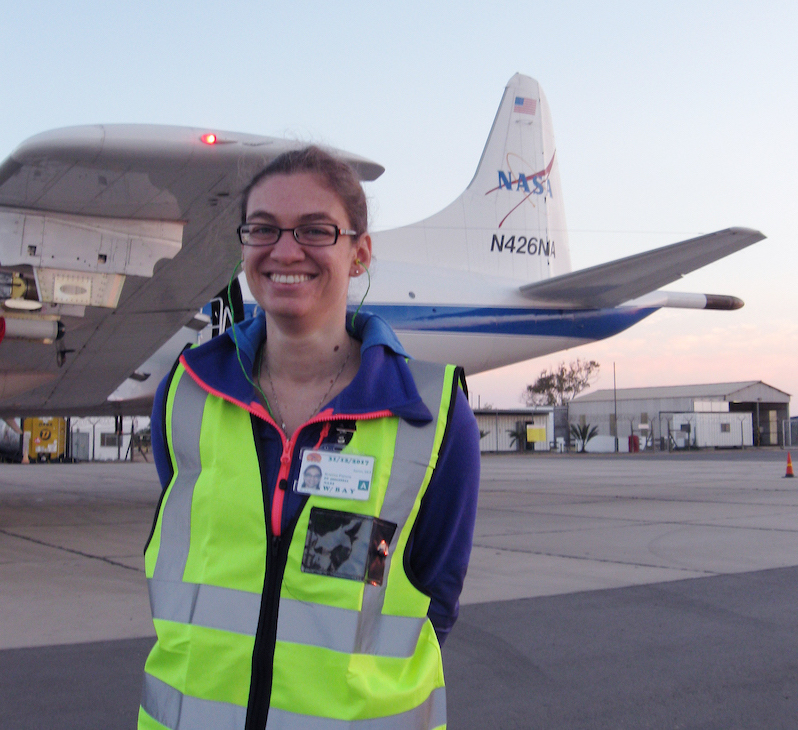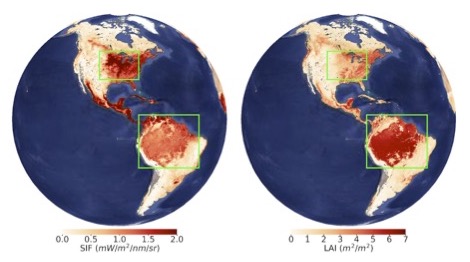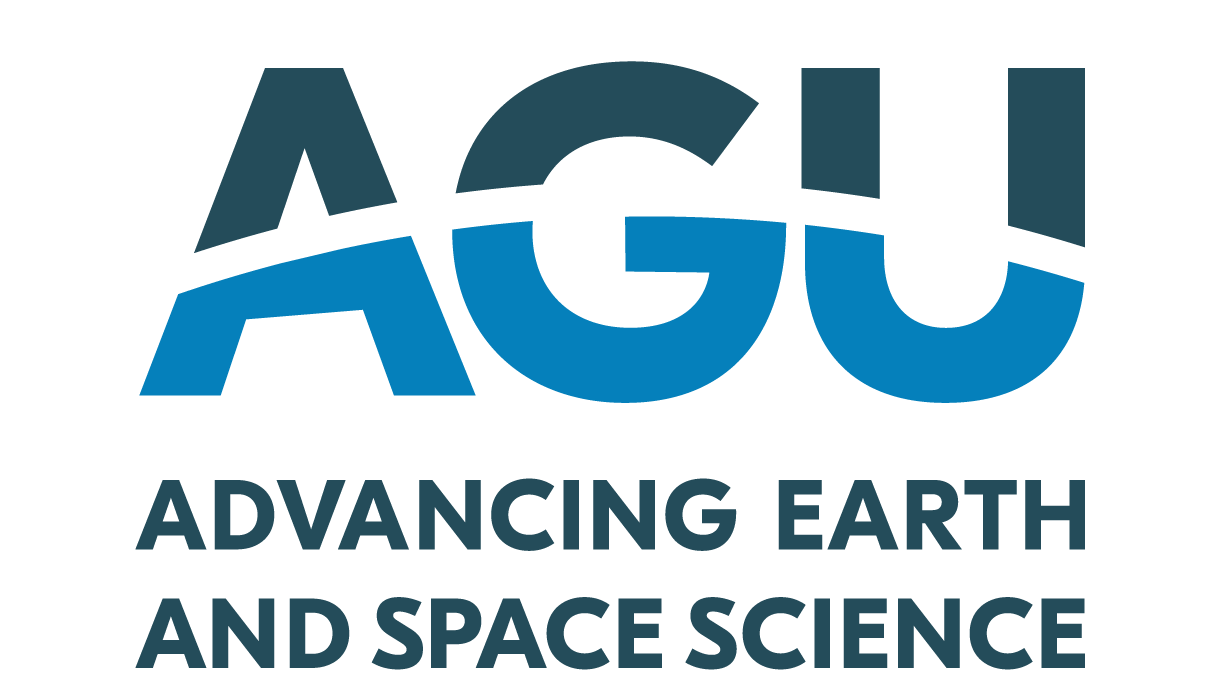For decades, scientists have used satellite data to assess the health and greenness of Earth’s…
In Conversation, Women at BAERI: Dr. Kristina Pistone
Dr. Pistone is a climate and atmospheric scientist, working for BAERI at NASA Ames Research Center. Her research examines aerosol-cloud interactions, air pollution, and she conducts science communication and outreach. Dr. Pistone was part of the recent NASA Earth Venture Suborbital field campaign ORACLES (Observation of Aerosols above Clouds and their Interactions), a five-year study evaluating the effects of aerosol particles and smoke in one of the largest cloud decks in the world, off the coast of South Africa.

Your research focus is aerosols and cloud interactions, can you tell me more about its importance?
As an atmospheric scientist I study how pollution affects clouds. A big unanswered question in terms of future climate is aerosols – a term for tiny atmospheric particles like smoke, dust, or sea salt. It’s an interesting area because we understand the effects carbon dioxide and other long-lived greenhouse gases have on the climate since they remain in the atmosphere for such a long time. This is partly because aerosols are relatively short-lived – a few days to weeks in the atmosphere, compared with decades to centuries for carbon dioxide – and also because their effects depend on the type of particle. For example, smoke versus dust.
An additional factor is how they affect cloud properties. For example, cloud droplet size and lifetime – like when/whether a cloud rains or evaporates. This is important to climate since the aerosols themselves will either warm or cool the atmosphere. Clouds reflect sunlight so any changes to them can produce a warming or a cooling effect. Not to mention changes in precipitation patterns which we care about, too!
What affect do aerosols have on a global scale?
Because the effects of aerosols are localized and variable it’s difficult to know or understand what that will mean globally and what it will be in the future. For example: What is the total effect from fires in Africa, plus power plant emissions in China, plus vehicle emissions in Europe and the US when each region may have different technologies and different emission standards to achieve their air quality goals that will also be changing with time. You can imagine how complicated it is to quantify the big picture!
Most atmospheric particles we emit last for about a week before they’re removed, usually by rain. Compare that to carbon dioxide, which lasts for about a century and has a chance to be fairly evenly distributed, globally! One of the interesting things we’re seeing in ORACLES is that the smoke from African fires seems to persist and get recirculated based on atmospheric dynamics.
What are things you are working on with your research that you enjoy? I think I remember reading you enjoy field campaigns?
I do enjoy working on field campaigns!
What was the last campaign you were part of?
I was part of ORACLES in 2017. That was in São Tomé [island off the coast of Africa].

What is it about the experience you enjoy?
With field campaigns you go out with a specific goal. There were likely years of logistic preparation to get you to that point, and (if you’re lucky) years of analysis after the fact, but in the middle of that you’re there! You’re usually going out to another place and collecting data with a limited amount of time and resources. There’s something special about being in the field when data is first being collected; also having the opportunity to interact with other researchers in the moment, being on the plane and looking out the window and being able to physically associate it with what the instruments are measuring. Maybe they’re unique measurements that haven’t been collected before, or part of a long-term dataset which allows us to better understand longer trends, or somewhere in between, but I find this kind of thing incredibly cool and exciting!

The vast majority of my research is in processing and analyzing data. Sometimes it’s easy to get caught up with Matlab (computer processing program) and you can sort of lose sight looking at the research and think, this is something we actually measured in the real world.
It’s a cool thing to do and I’m glad we were able to be part of it.
Hearing stories that you work in the field and, in a sense, the story behind the numbers you get, from point A to point B. You are doing science work. How long does it take to make sense of the data you collect?
It can be long time. I have a paper that is being reviewed now that is using data from ORACLES 2016. So, 2 years and a bit from when the data was collected to when it was submitted.
Good science takes time.
I think so. Particularly when we’re dealing with observations; we need to collect the data, calibrate instruments, apply quality controls, deal with a lot of logistics before we even start on a meaningful data analysis. And I may have fewer publications because of that but I hope that means the publications are higher in quality. One of the challenges in science is feeling that need to constantly publish, but we don’t always know all the answers right away. A lot of science happens more incrementally. But of course, we do need to publish because that’s how science gets communicated within our own field. I’m trying to get better at breaking up my research into publishable units, which probably won’t answer all the questions but hopefully will answer one piece of the puzzle we are trying to understand.
And with the last ORACLES deployment behind us we’re hopefully going to be seeing a whole lot more papers in the next few months!
Would it be fair to say that in your work a large part of it is looking at Earth climate models and how to make them better? Would you say that’s accurate?
In climate science, you have experimentalists, modelers, and lab people, which all have different roles in understanding the Earth system. I’m on the observational side of things, which deals mostly with what does the real world look like. The modelers use their computer simulations to hopefully tell us why the real world looks what it does.
Lab scientists can take this theory and perform more controlled tests than we’re able to do out in situ. If the model results don’t match what’s observed in the field or in the lab that probably means some mechanism or some process (or combination of processes) are not fully captured or missing from the model. The motivation that comes up a lot is that we need observations to make our models more accurate. The representation of aerosol properties and processes in the models is something that has historically been difficult to fully capture.
For example, the ORACLES aerosol paper that we have in ACPD [Atmospheric Chemistry and Physics] right now is looking at aerosol properties that we measured from many different instruments and this SSA property (single scattering albedo) is often assumed to be a certain value in models or in satellite retrievals. If we have a better idea of what the observed values are, we can improve the calculations which assume a particular SSA value.
I’m curious about people’s life journey on the path towards science. What sparked your love for science?
As an undergrad I majored in physics with specialization in astrophysics. I did a summer program called REU (Research Experience for Undergraduates, an NSF program) and found that research was something I enjoyed and started thinking graduate school was something I might want to pursue.
In my 4th year of undergraduate work, I took an elective class on the physical climate system cross-listed between physics and the Scripps Institution of Oceanography which mostly focused on the Earth’s radiative balance. In physics, there’s a concept called a black body, which is an object that absorbs all energy that hits it (i.e. black) and re-radiates it away as heat; the amount of energy it has to equal the amount of energy out. Radiative balance in climate science is basically applying this model to the Earth: the amount of sunlight coming in has to equal the amount of infrared radiation that’s radiated away from the top of Earth’s atmosphere.
But, of course, this is a significant simplification. The Earth has an atmosphere made up of various gases, and ocean, land, clouds, ice, which are absorbing, reemitting, reflecting, scattering both the sunlight and the infrared (heat) energy; but at a fundamental level, this is basically just physics that’s applied to the Earth’s system. And I thought, Okay, this is really cool! I want to pursue this more in graduate school! I was accepted to Scripps Institution of Oceanography, UC San Diego. The professor who taught that course ended up on my dissertation committee.
It has been a cumulative process I think. There wasn’t one defining moment that led me to where I am. I majored in physics because I had a really good AP Physics instructor in high school, found it to be an enjoyable subject, and wanted to pursue it further. So, if I hadn’t had that particular instructor it’s entirely possible I may not have made that choice. A professor I worked with during a summer program at UCLA during my 3rd year of undergrad, was an astrophysics professor; yet he was the first one to show me the Keeling Curve which is a graph of a long-term data set showing the accumulation of carbon dioxide in the Earth’s atmosphere from 1958 to present day. And that summer program opened my eyes to the possibility of graduate school and research as a career.
I’ve been fortunate enough that I was able to pursue what I wanted to study in school and I was fortunate to get into a grad school where I was able to thrive. It was more a set of cumulative nudges in one direction that, conversely, one sees how easy it can be to nudge potential scientists out of science. I like to do outreach programs, like Skype a Scientist, and I hope that adds a few more nudges in the direction of science.
How important is it to have mentors? Or, who would you say inspires you?
Having great mentors is crucial. Part of the reason I was successful in my PhD program was in large part the interactions I had with postdocs, being part of a great lab, as well as my advisors. Having that exposure, support, and guidance made a big difference going through my PhD. I had a good collaborative and supporting community. This is how I approach my work in general. I enjoy a collaborative work space. Some people can do it alone, but I find my work usually benefits from having more eyes and more input, having the opportunity to bounce ideas off people.
Beyond my own particular research niche, Dr. Katharine Hayhoe is a climate scientist and is involved in science communication. She also happens to be an evangelical Christian, so she’s able to talk science to a particular group of people who are not usually brought into the conversation about science or climate science. I respect her ability to communicate science and scientific knowledge to different segments of the population.
I have all the respect in the world for people like Dr. Hayhoe or Dr. Michael E. Mann who are able to do both, especially on an open platform like Twitter, as that can bring out trolls against women scientists.
Speaking of communicating, how important do you feel science communication is?
Yeah, I feel this is incredibly important. A lot of our research (NASA, NOAA, NSF, DoE projects) is funded by taxpayer money. In this context, the public deserves to know the research we are working on. However, it can be difficult, depending on the audience, since it is also a full-time job to be able to communicate effectively. There’s a balance that has to happen between doing research but also communicating your research beyond writing scientific papers. How the scientific or academic community communicates within itself is not how nonscientists communicate. Much of it has to do with framing and forming a strong narrative about your research, something that we, as scientists, are not necessarily trained to do. But I think it is important for someone to do it!
Have you found anything about climate science that has surprised you?
In terms of the mechanics of “science” it’s definitely coding. And also, statistics! Nobody told me that I should know how to code until my third year of undergrad study; so I feel like I’ve been playing catch-up ever since. I use MATLAB and I’m trying to learn more Python as it has some other advantages (including being open-source). But our instrument processing code uses MATLAB, or for the foreseeable future, MATLAB will be involved.
In terms of climate science, it’s probably how complex these aerosol-cloud interactions can be. There are many aspects of the climate that we understand fairly well (for example, the impacts of long-lived carbon dioxide emissions). But for aerosols the answer to, “What is the effect” is often basically “It depends.” It depends on the meteorology, the cloud type, the aerosol type, and aerosol age. But if we had all the answers right away then there wouldn’t be anything left to research!


